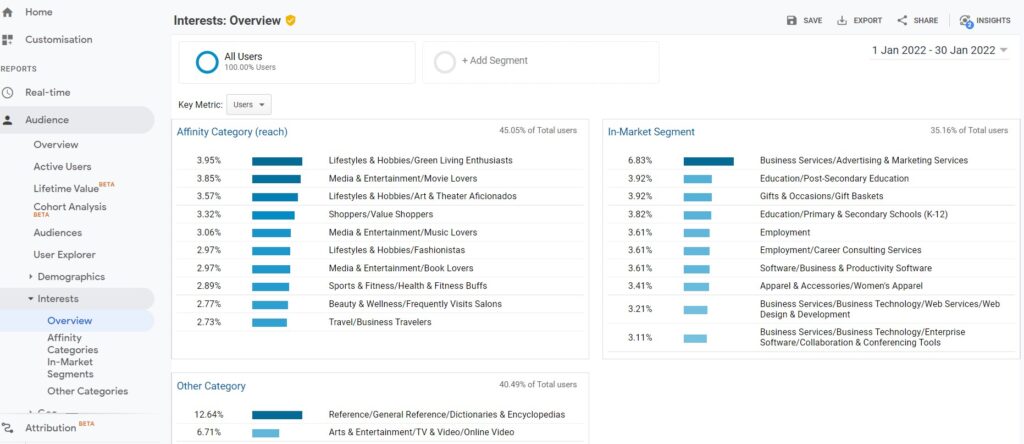Guide to Content Marketing Strategy
Right now, someone, somewhere around the world, will type a question into Google’s search bar. Maybe they will want to find out why the sky is blue. Perhaps they might like to learn how to fix that leaking tap in their kitchen. Who knows? Humans are innately curious creatures, and we have a big appetite for answers. There’s no telling what the next question will be.

With their question at the ready, they will press the Google search button and, in less time than it takes for you to blink, they will open up the gates to an immense library of knowledge:
In other words, they will land on a search results page. Quite like the one below:

Thousands of search results will illuminate their smartphone’s sleek, glass screen. YouTube videos, blog posts, e-books, Wikipedia articles – you name it. And there, in that tiny corner of the Internet, they will find the answers they are searching for.
This journey is being repeated billions of times every day.
According to HubSpot, it’s estimated that Google processes approximately 63,000 searches every second. That translates to roughly 5.6 billion searches per day and about 2 trillion searches per year.
Once upon a time, in a not-so-distant past, we would have had to sift through thick, heavy books to find the answers to our burning questions. Nowadays, we have more options. We can find a lot of the solutions we need digitally, behind the glass screens of our smartphones, laptops and tablets.
There are billions of users searching for answers on the Internet. When you create content that delivers responses, you create opportunities to connect to the right audience, at the right time and in the proper context.
And you see, that’s just the sublime beauty of content marketing.
How content marketing creates industry leaders
By becoming an authoritative, credible resource on the topics that matter to your prospective customers, you’re more likely to earn their trust. And trust is the magic wand that turns prospects into advocates and supporters.
Be it an educational article, infographic, e-Book, podcast or 1-minute TikTok clip – what makes your content resonate is the value it provides to customers. How you deliver that value is up to you -whether by writing an article explaining why the sky is blue or creating a step-by-step video guide on fixing a leaking tap.
Striking a balance between promoting your brand whilst also meeting the preferences and needs of your customers is a fine line every marketer has to tread.
The context in your content
Context is vital in marketing. Think of all the interests vying for a second of your customer’s attention. From the smartphone in their pocket to the signs on city buses, from brightly lit billboards to snappy 10 seconds adverts on TV, we are surrounded by marketing content everywhere.
In a busy world that is forever moving, context should lay at the heart of your content marketing strategy.
When you approach marketing with a context in mind, you present your marketing messages in a way that is relevant to each customer.
When we talk about creating content with context in mind, we’re thinking about the why, what and when:
- Why – Why are you creating your content? Whether you want to entertain, educate, save money or time, your content should meet the wants and needs of the intended recipient.
- What – What format will you use to present your content? Think about the type of content that will resonate with your audience the most. Would long 3,000-word blog posts grab their attention? Or are fun, snappy YouTube videos the way to go? You may need to adapt how you present your content depending on what platform it will reside on.
- When – When will you deliver your content, and how often? Is timing important based on your channel?
To help you navigate your content marketing strategy, we have created an in-depth guide bundled with tips and insights.
1. Set quantitative, qualitative and time-specific goals
Thanks to all that information at their fingertips, today’s customers are more informed than ever before. As they search for products and services, customers will make informed choices each step of the way. They may sift through your reviews on Google Reviews and Trustpilot, or they may, say, sign up for your weekly newsletter. The bottom line is this:
More often than not your prospects will go through a series of steps before they make a purchasing decision. To successfully increase revenue, you need to be present in all phases of their journey, from the search phase to the moment they press the “buy now” button.
Qualitative, quantitative and time-specific goals can help you measure the success of your content strategy at different phases of the buyer’s journey.
Here are some examples of what those goals might look like:
- Improve search ranking to maximise organic traffic from search engines.
- Exceed a certain number of new email subscribers per month.
- Increase page views, sessions and engagement on site
- Achieve monthly, quarterly or yearly revenue target
2. Know your audience
When you understand your target audience well, you can tweak and fine-tune your content to suit them. Then you can distribute it in the platforms they frequent, in a format they’d readily consume, and in a way that tailors to their behaviours, motivations and inherent challenges.
With the help of Google Analytics’ powerful tools, you can collect demographics on your website visitors, social media followers and email subscribers.
- Age
- Gender
- Education
- Income
You’ll also get insight into their key interests. To find this information in Google Analytics, go to Audience » Interests » Overview. You’ll see the market segments your web visitors fit into.

3. Find the best content channels
It can sometimes feel as if there’s a new trend, strategy or quick-fix tactic every ten minutes. When choosing a content channel, the barrage of options can get overwhelming. Just remember this:
Every platform has its unique context.
Instagram is a highly visual and engaging platform, perfect for capturing your company’s personality and culture behind the lens of a Nikon camera.
Twitter is perfect for sassy, snappy posts packed with humour and style. There’s no room for 5,000-word blog posts here.
LinkedIn is for content that blurs the line between work and leisure.
Search for the platforms, communities and channels your customers visit to collect and evaluate their information. Then, find the online spaces where they hang out and connect with them there.
4. Create content
So, you’re now ready to create your content, but there’s just one glaring problem staring you in the eye: you don’t know what to make. Research should drive your content creation journey, whether you’re contending with a blank, Word document page or zero seconds of camera footage.
First, ask yourself these questions:
- What is out there already?
- Can I ask a question that nobody else is asking? Do I have the answer to that question?
- Can I make a bold statement?
- How can my content add even more value to my audience?
- How can I reframe the conversation in an unexpected way?
Let the answers to these questions form the foundation of your content. When it comes to researching content, I recommend two techniques:
The Skyscraper Technique and Search Listening.
1. The Skyscraper Technique
Browse the Internet for all the best-performing content on your topic, and find ways to brush up that content and make it even better.
You may be able to add valuable insight to the conversation. You may have gathered compelling data that supports a different perspective. Find the best content in your industry, and do better
2. Search Listening
Search listening is when you analyse the searches and trends circling your brand and industry.
Answer the Public is one powerful search listening tool. You can use it to better understand the questions people search for around your topic.
Type any subject into the Answer the Public search bar, and they’ll create a list of questions people have searched for you.
Foe help with your content marketing strategy, get in touch with one of the team today.
